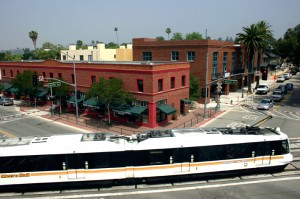If we build it, they will come. For many years, that was the mantra of rail transit planners. Just build the rail line, and development will happen around the stations. And then more people will ride, and the system will be a good investment.
But in California, too often that hasn’t been the case. Much of our prime real estate within an easy walk (half-mile) of urban rail lines has been wasted — a victim of bad planning, poor market conditions, and/or restrictive local zoning. As a result, recalcitrant California cities push new growth into outlying areas, sprawling over open space and farmland, increasing traffic and air pollution, and creating an artificial and extreme shortage of housing that drives up rents and home prices and squeezes businesses and residents alike.
 Today the nonpartisan research organization Next 10 is releasing a report authored by the Center for Law, Energy and the Environment (CLEE) at the UC Berkeley School of Law that seeks to evaluate how well California is taking advantage of rail transit stations. Using existing data from such sources as Walk Score and the Center for Neighborhood Technology, CLEE developed a scorecard of 11 indicators, including factors like walkability, affordability, percentage of residents and employees who use transit, and number of jobs and households within 1/2 mile radius. We then used that information to grade 489 transit stations in 6 rail systems across the state, excluding commuter lines like Metrolink and Caltrain and Amtrak, but including L.A.’s bus rapid transit line given it’s rail-like qualities.
Today the nonpartisan research organization Next 10 is releasing a report authored by the Center for Law, Energy and the Environment (CLEE) at the UC Berkeley School of Law that seeks to evaluate how well California is taking advantage of rail transit stations. Using existing data from such sources as Walk Score and the Center for Neighborhood Technology, CLEE developed a scorecard of 11 indicators, including factors like walkability, affordability, percentage of residents and employees who use transit, and number of jobs and households within 1/2 mile radius. We then used that information to grade 489 transit stations in 6 rail systems across the state, excluding commuter lines like Metrolink and Caltrain and Amtrak, but including L.A.’s bus rapid transit line given it’s rail-like qualities.
The results are on a curve, with the top 50% of station areas receiving A’s and B’s, and the bottom 50% receiving C’s and D’s (the bottom 2% get F’s). Stations are divided by and compete within three place types (residential, employment or mixed).
We found that each transit system has successful stations, typically located in downtown-like environments with walkability and good connection to amenities. San Francisco’s MUNI light rail system scored the best on average, with the top performing station statewide at Market Street and Church Street.
Other notable findings:
- San Diego’s Gillespie Field Station, located in a car-dependent and otherwise barren wasteland, received an F—scoring poorly across the board.
- LA Metro Rail’s best-scoring station is Westlake/ MacArthur Park station, which scores high on diversity of destinations, walkability, transit access, and affordability, but gets a poor mark on safety.
- Sacramento’s Longview Drive and I-80 station is next to a major interstate and used primarily for park-and-ride services. It is the region’s lowest-scoring area in terms of fostering a vibrant transit neighborhood, with very low train use among local residents and workers.
- The San Joaquin Valley is California’s fastest-growing region but lacks rail transit. As a result, we analyzed key busy bus station areas instead, awarding them separate grades ranging from B to D.
Overall, Santa Clara’s VTA and San Diego’s MTS systems scored the worst in the state, with many auto-oriented, derelict station areas, including along highways. After MUNI, BART was second and LA Metro Rail and Sacramento RT were tied for third, in terms of highest average score. You can access all the materials for the report here.
So what can be done to improve scores? First, local leaders with stations in their jurisdictions should plan for and encourage thriving, walkable neighborhoods around the stations. Second, state leaders can help underperforming areas that lack a market for new development by focusing state investment and financing programs in those areas, such as through green bonds and tax-increment financing. Finally, transit leaders should condition any rail expansion on a local commitment to transit-oriented development around the stations, and they should consider reducing service to underperforming stations in order to better serve stations with thriving neighborhoods around them.
Without steps like these, we risk wasting rail investments and exacerbating the state’s environmental and economic challenges. Future growth in the state should be focused along our existing rail transit networks, instead of pushed outward along highways. Ultimately, the scorecard reveals which station areas we should emulate, and which ones policy makers should focus on for improvement.
About Ethan Elkind
One thought on “New Report: Grading California’s Rail Transit Station Areas”
-
Pingback: A Closer Look At L.A. Metro Rail Station Area Grades | Ethan Elkind
Leave a Reply Cancel reply
You must be logged in to post a comment.


